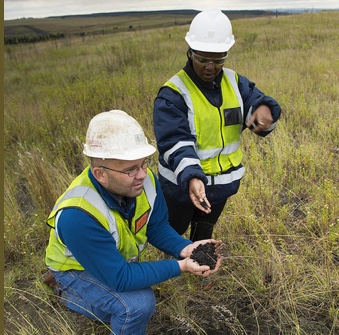Looking at an environmentally stabilizing mine remediation technique

Anglo American Thermal Coal - Environmental - Kleinkopjie Colliery . Gustav Le Roux, rehab planner, and Dolly Mthethwa, environmental co-ordinator, in
Anglo American Thermal Coal - Environmental - Kleinkopjie Colliery . Gustav Le Roux, rehab planner, and Dolly Mthethwa, environmental co-ordinator, inspect the results of the Fungcoal trials on the Klipan discard dump where a bacteria has been introduced to reduce the rough discard into viable organic material in which plants will grow. — Photo courtesy Philip Mostert
Traditionally, mine remediation consists of reshaping the contours of the land, covering the disturbed area with subsoil and topsoil, and reseeding. Costs are high and issues with regeneration can require repeat treatment and negative impacts on surrounding areas.
Topsoil is also in receding availability—the world’s supply is experiencing a loss rate 10 to 100 times higher than its replacement rate and some sources say, according to current degradation rates, the world only has about a 60-year supply remaining.
Fungcoal significantly reduces the need for topsoil, while providing an environmentally useful application for discard coal.
A mixture of fungi and discard coal, fungcoal can, according to testing, speed up the rehabilitation process by harnessing the power of organisms already existent in nature.
Henk Lodewijks, mine closure manager at Anglo American’s coal business, said the original intent was to develop a cost-effective alternative to alcohol, which was used in the early 2000s as a carbon source in a biological sulphate reduction plant built at Landau Colliery to treat acid mine drainage.
The initiators were Anglo American’s Bielie van Zyl and Professor Peter Rose of Rhodes University.
“The focus was on the biosolubilisation of weathered coal, creating a carbon-rich liquid acceptable to the micro-organisms responsible for the sulphate reduction,” said Lodewijks.
“This particular application did not come to fruition, but in the course of the investigation, it was realized that an alternative application of the biosolubilisation of weathered coal lay in rehabilitation of open-cast coal mines and coal discard dumps.”
The efficacy of fungcoal depends on its ability to break down and liquefy coal that has been exposed to the elements. Combined with fungi, the substance generates humic and fulvic acid-like substances, which are natural soil fertilizers considered the building blocks of soil fertility.
Humic and fulvic acids promote soil microbe and plant growth while significantly alleviating one of mining’s greatest rehabilitation challenges—the compaction or hardening of rehabilitated soil.
Fungcoal can be applied anywhere there is a ready source of weathered coal available and the weathered coal responds positively to fungcoal treatment.
“If these conditions are met, then potential savings in rehabilitation can be made by reducing the volume of topsoil required for conventional rehabilitation and by improving the quality of rehabilitation by increasing the organic content of the topsoil,” said Lodewijks.
The technology has achieved positive results on trial at four of Anglo American’s coal mines where it is being tested for use on rehabilitated mining pits and coal discard facilities covering 30 hectares.
“Fungcoal is still in trial,” said Lodewijks. “Discard dump and open-cast rehabilitation is a multi-year exercise and fungcoal needs to prove that the technology is sustainable in the long run.”
The current priority for Anglo American is to prove the technology and get it accepted by all stakeholders. “In order to facilitate an easy and wide application, Anglo American will not charge a licence fee for the time being,” said Lodewijks, “but reserves the right to do so at a later stage.”



